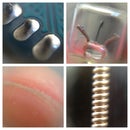Introduction: Amp Footswitch
When I play guitar, I often switch between clean and overdrive, and I sometimes need to turn chorus on and off. The problem here is that the buttons on my amp are about 1/4" squares, smack dab in between the knobs. When I don't want to reach down to change settings, sometimes I can manage to use my toe to push the buttons, but often times I end up messing with the knobs accidentally.
While looking at my amp's manual, I saw that the label for the footswitch jack designated the functions of the TRS (Tip-Ring-Sleeve, or stereo) plug that would plug into the jack. It was then that I had the idea that I should make a footswitch instead of buying one, just like any self-respecting geek would do.
By making my own footswitch, I was able to save a ton of money. Most dual-button footswitches run somewhere around $50 or so, yet I was able to make mine for under $10.
Step 1: Parts and Materials
The parts are pretty straightforward, but can be changed depending of what you already have.
Parts:
- 2 Push On/Push Off buttons*
- a 1/4" Male Stereo plug (I prefer solder-type)
- a cable of some sort with at least 3 conductors**
- an enclosure that will fit the switches
- you may need some hookup wire, but it's unlikely
*I have heard of amps that require a momentary switch instead of a push on/push off type. You can check what you need by touching the wires for the switch together and seeing what happens.
**I used an old RCA audio cable, which has 2 conductors in each wire, then I soldered one from each together forming a common ground
Tools:
- Wire strippers
- Soldering iron & solder
- Drill with bits to match your buttons
Step 2: Pre-mounting Prep
With the buttons I got, you have to mount them before you solder. Because of this, I prepared everything else before soldering the buttons. The first thing you need to do it drill 3 holes in your box: 2 for the buttons and 1 for the cable to come out the back side.
Next, solder the male stereo plug. I snipped the connectors off the RCA cable, stripped the wires inside, and prepped them by tinning them with solder. Because I had 4 individual wires and I only needed 3, I soldered both the outer ground wires to the ground lug on the male plug. Then one of the insulated, colored wires went to each the "left" and "right" lugs on the plug.
Do the same prep work to the other end of the cable, but leave everything separate for the next step, then put the cable through the hole you made in your enclosure.
Step 3: Soldering & Mounting the Buttons
Now the time has come to mount the buttons and get this finished up. Put the buttons through the holes you've made and tighten them down with the hardware they came with. Then pull the cable through its hole and get ready to solder some buttons. From the RCA cable, one "channel" (like the left or right) will go to each switch. In effect, each button is connected to one of the signal lines (the left or right from the plug) and common ground.
Step 4: Finish It Up
At this point you should be able to close up your enclosure and test your new footswitch on your amp. Mine worked the first time. If yours doesn't, make sure you have it wired correctly. Each switch should be connected to common ground (the sleeve of the plug) and either the left or right channel (the ring or tip of the plug). Have fun and happy channel switching!













